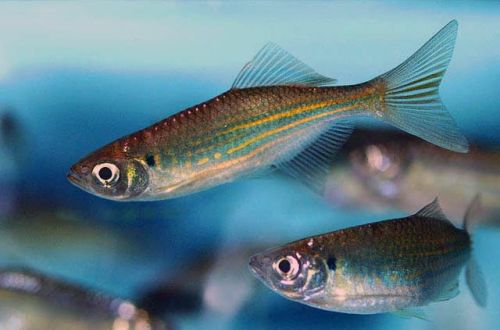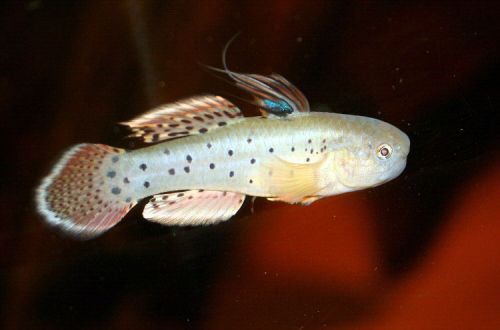
Danio royal
Danio royal, scientific name Devario regina, belongs to the Cyprinidae family. The word “royal” in this case does not mean any exceptional features of this fish. Outwardly, it is not much different from other relatives. The name comes from the Latin “regina” meaning “queen”, in honor of Her Majesty Rambani Barney (1904-1984), Queen of Siam from 1925 to 1935.

Contents
Habitat
It comes from Southeast Asia from the territory of southern Thailand and the northern regions of peninsular Malaysia. Records have been found in a number of sources that the fish is also found in India, Myanmar and Laos, but this information, apparently, applies to other species.
Inhabits streams and rivers flowing through hilly areas under the canopy of tropical forests. The habitat is characterized by clear running water, gravel and rock substrates of varying size, and some riparian aquatic vegetation.
Brief information:
- The volume of the aquarium – from 250 liters.
- Temperature – 20-26°C
- Value pH — 5.5–7.0
- Water hardness – 2–15 dGH
- Substrate type — stony
- Lighting – any
- Brackish water – no
- Water movement – light or moderate
- The size of the fish is 7–8 cm.
- Food – any food
- Temperament – peaceful
- Keeping in a group of 8-10 individuals
Description
Adults reach a length of 7-8 cm. The fish has a blue-yellow color pattern on the body. The back is grey, the belly is silvery. This coloration makes it related to the Giant and Malabar Danio, which is why they are often confused. You can distinguish Danio royal by its large tail. True, this difference is not so obvious, therefore, it will be possible to determine the species affiliation only if the fish is adjacent to its relatives. Sexual dimorphism is weakly expressed, male and female are similar to each other, the latter may seem larger, especially during the spawning period.
Food
Unpretentious in terms of diet, accepts most popular foods designed for aquarium fish. For example, dry flakes, granules, freeze-dried, frozen and live foods (bloodworm, daphnia, brine shrimp, etc.).
Maintenance and care, arrangement of the aquarium
Recommended aquarium sizes for a school of 8-10 fish start at 250 liters. A design that mimics the natural habitat is considered preferable. It usually includes rocky ground, a few snags, and a limited number of aquatic plants or their artificial variants.
Successful keeping is possible provided that the water has the necessary hydrochemical composition and temperature, and the amount of organic waste (feed residues and excrement) is minimal. For this purpose, a productive filtration system combined with an aerator is installed in the aquarium. It solves several problems – it purifies water, provides an internal flow that resembles the flow of a river, and increases the concentration of dissolved oxygen. In addition, several care procedures are mandatory: weekly replacement of part of the water (30–40% of the volume) with fresh water, monitoring and maintaining stable pH and dGH values, cleaning the soil and design elements.
Important! Danios are prone to jumping out of the aquarium, so a lid is a must.
Behavior and Compatibility
Active peaceful fish, get along well with other non-aggressive species of comparable size. They prefer to be in a flock of 8-10 individuals. With a smaller number, they can become intimidated, slow, life expectancy is greatly reduced. Sometimes not reaching even up to one year.
Breeding / breeding
Breeding is simple, under suitable conditions and when fed with balanced quality feed, spawning can occur regularly. Fish scatter a lot of eggs right to the bottom. Parental instincts are not developed, there is no concern for future offspring. Moreover, Danios will definitely feast on their own caviar on occasion, so the survival rate of fry in the main aquarium is minimal. Not only are they at risk of being eaten, but they will also not be able to find suitable food for themselves.
It is possible to save the brood in a separate tank, where the fertilized eggs will be transferred. It is filled with the same water as in the main tank, and the set of equipment consists of a simple airlift filter and a heater. Of course, it will not be possible to collect all the eggs, but fortunately there will be a lot of them and it will certainly turn out to bring out several dozen fry. The incubation period lasts about 24 hours, after a couple of days the juveniles will begin to swim freely. From this point on, you can feed a specialized powdered food, or, if available, Artemia nauplii.
Fish diseases
In a balanced aquarium ecosystem with species-specific conditions, diseases rarely occur. Often, diseases are caused by environmental degradation, contact with sick fish, and injuries. If this could not be avoided and the fish shows clear signs of illness, then medical treatment will be required. Read more about symptoms and treatments in the Aquarium Fish Diseases section.





